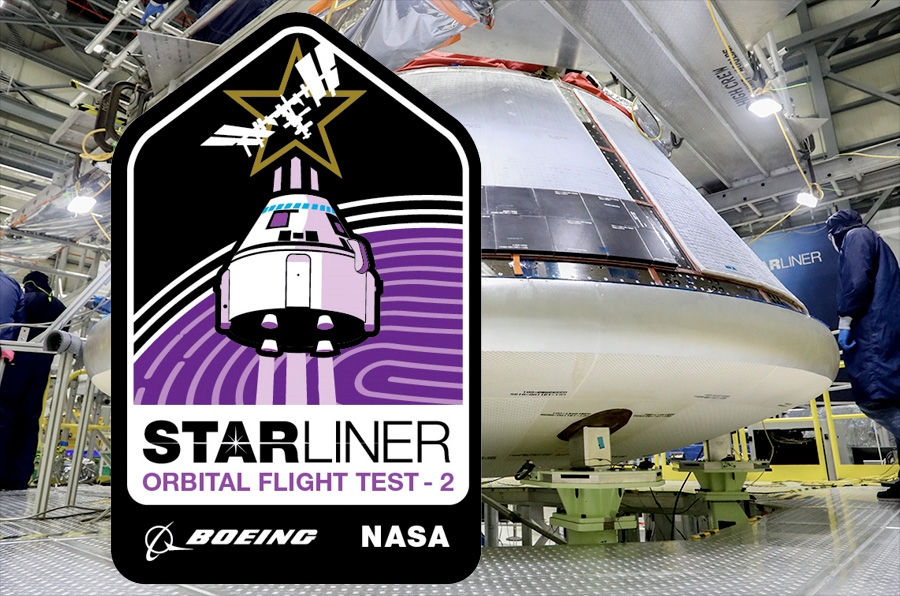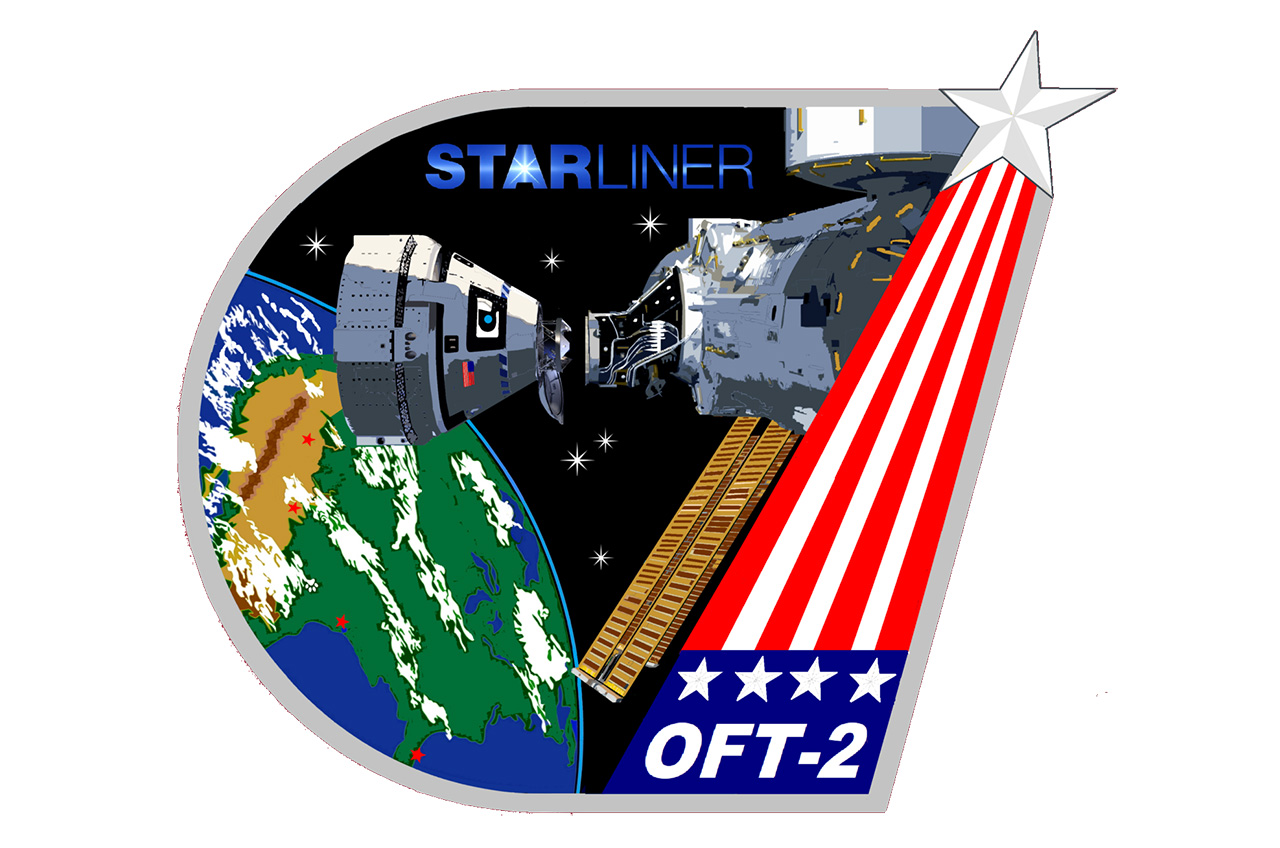Boeing reveals mission patch for second Starliner orbital flight test

As final touches are being put on Boeing's next Starliner spacecraft to launch, the aerospace company has revealed a new mission patch representing its team's hands-on approach to ensuring the capsule's safe flight.
Boeing is targeting March 29, 2021 for the launch of its second uncrewed Starliner on a test flight to the International Space Station. The Orbital Flight Test-2 (OFT-2) will verify the performance of the spacecraft's flight software, which on the first OFT prevented the Starliner from reaching the space station in December 2019.
Similar in style to Boeing's other Starliner test flight patches, the OFT-2 mission patch prominently features a thumbprint pattern in recognition of the unique and diverse teammates who are working to prepare the Starliner. The fingerprint, which overlays the emblem's depiction of Earth, belongs to the Boeing employees who have built the spacecraft, as well as those who have had a hand in designing, testing, coding and training for the OFT-2 mission.
Related: Boeing's 1st Starliner flight test in photos
"The success of the OFT-2 mission will be a reflection of the determination and diligence of my teammates on the Starliner program," Chris Ferguson, Boeing's director for Starliner Crew and Mission Operations and a former NASA astronaut, said in a statement. "This mission is personal to them and to our company. We wanted this patch to reflect that."
During the OFT-2 mission, the CST-100 Starliner spacecraft will launch on a United Launch Alliance (ULA) Atlas V rocket from Complex 41 at Cape Canaveral Space Force Station in Florida, dock to the International Space Station and return to land in the western United States about a week later as part of an end-to-end test to prove the spacecraft is ready to fly with a crew.
The OFT-2 Starliner is nearing final assembly inside Boeing's Commercial Crew and Cargo Processing Facility at NASA's Kennedy Space Center in Florida. The vehicle's reusable crew module has been powered up and final checkouts of the avionics, power and propulsion systems are nearing completion. The spacecraft's parachutes, landing airbags, base heat shield and its back shells are installed, signifying the completion of the vehicle's build phase.
Video: Watch Boeing test Starliner's parachutes one last time
Get the Space.com Newsletter
Breaking space news, the latest updates on rocket launches, skywatching events and more!

In the weeks leading up to the late-March launch, teams will load the capsule with cargo — including "Rosie the Rocketeer," an instrumented mannequin that flew on the first OFT — and weigh the vehicle before mating it to its service module, which is already complete.
The OFT-2 patch trades the blue tones of the OFT emblem for a predominantly purple color scheme reflecting the devotion and pride that Boeing's Starliner team has for the program and its future.
The three white lines that curve above Earth on the patch represent Boeing's steps to reaching low Earth orbit and Starliner's three flight test missions to space (OFT, OFT-2 and the Crewed Flight Test, or CFT, to follow a successful OFT-2 mission). The International Space Station is depicted in its entirety to symbolize Boeing's commitment to docking there and achieving all of the OFT flight test objectives. A rendition of NASA's astronaut emblem — the three lines converging at a star — tops off the patch, demonstrating that crew safety is Boeing's top priority, according to the company.

In addition to revealing the OFT-2 mission patch, Boeing also provided a look at the mission operations insignia that will represent the contracted NASA flight controllers who will oversee the test fight from the Christopher C. Kraft, Jr. Mission Control Center at Johnson Space Center in Houston. Based on the general shape and design of the original mission operations team insignia, the OFT-2 version adds the space station's docking port as the primary objective for the test flight.
Boeing is working hand-in-hand with NASA to address all of the lessons learned from Starliner's first OFT. The company is more than 90 percent complete in closing out all the recommended actions developed by a joint NASA and Boeing independent review team ahead of Starliner's second uncrewed flight test.
Following a successful OFT-2, Boeing anticipates launching its first Starliner with astronauts in the summer of 2021. The Crewed Flight Test (CFT) patch, which was first revealed in April 2019, remains in use, though it has been updated with the names of the recently-revised crew: NASA astronauts Barry "Butch" Wilmore, Mike Fincke and Nicole Mann.
Follow collectSPACE.com on Facebook and on Twitter at @collectSPACE. Copyright 2020 collectSPACE.com. All rights reserved.
Join our Space Forums to keep talking space on the latest missions, night sky and more! And if you have a news tip, correction or comment, let us know at: community@space.com.

Robert Pearlman is a space historian, journalist and the founder and editor of collectSPACE.com, a daily news publication and community devoted to space history with a particular focus on how and where space exploration intersects with pop culture. Pearlman is also a contributing writer for Space.com and co-author of "Space Stations: The Art, Science, and Reality of Working in Space” published by Smithsonian Books in 2018.In 2009, he was inducted into the U.S. Space Camp Hall of Fame in Huntsville, Alabama. In 2021, he was honored by the American Astronautical Society with the Ordway Award for Sustained Excellence in Spaceflight History. In 2023, the National Space Club Florida Committee recognized Pearlman with the Kolcum News and Communications Award for excellence in telling the space story along the Space Coast and throughout the world.








